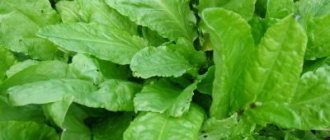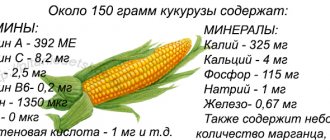What are the benefits of sauerkraut?
What makes sauerkraut unique is that it contains both prebiotics and probiotics. Due to this, the intestinal microflora improves and the intensity of decay processes decreases (disappears). This product is especially useful for bisbacteriosis, when the body does not produce microorganisms necessary for the formation of normal intestinal microflora. The acids contained in sauerkraut - acetic and lactic - help in the fight against pathogenic microbes.
Dentists note the positive effect of regular use of the product - not only the gums, but also the teeth become stronger. Due to the antibacterial effect, the likelihood of stomatitis and other oral diseases is reduced. It is recommended to eat sauerkraut for dyspepsia, and it is also considered one of the best means of preventing scurvy. Other useful properties:
- Increases immunity. This effect is ensured thanks to pre- and probiotics, supplemented with ascorbic acid and other vitamins.
- A source of vitamins from October to May - at this time it is extremely important to ensure that the body receives a sufficient amount of nutrients.
- Helps reduce blood cholesterol levels - this effect is achieved through flavonoids.
- The isothiocyanates contained in sauerkraut reduce the likelihood of developing malignant tumors in the lungs, intestines, liver and mammary gland. True, research in this direction has not yet been completed.
- Sauerkraut contains B vitamins, which ensure better digestibility of other foods. Thanks to this, the body receives more protein. It’s not for nothing that sauerkraut is considered an ideal partner for meat dishes - this is typical for Russian, German, Czech and Slovak national cuisines.
- Strengthens the walls of blood vessels, reduces the likelihood of nosebleeds.
- With regular use, it stabilizes lipid metabolism and improves blood composition, including blood clotting.
- Sauerkraut is recommended to be consumed to prevent ulcers.
- The folic acid it contains accelerates cell recovery.
- Sauerkraut juice is used to increase appetite - it acts as a catalyst for the digestive system.
Sauerkraut helps well with chronic gastritis with low acidity. It is enough to consume it half an hour before meals for 15–20 days. It also helps lower blood sugar levels, which is why it must be included in the diet of diabetics.
To improve liver activity, a so-called “health cocktail” is used. To prepare it, mix equal parts of tomato juice and cabbage brine. You should drink it three times a day. People use brine to remove Giardia - if you drink it 25-30 minutes before meals, you can remove them from the liver.
Recipes for sauerkraut and cabbage soup for kids at home
Sauerkraut is included in many recipes for first and second courses, various salads and appetizers. In order for the child’s body to tolerate a new product well, it is best to prepare it yourself. It won’t take much effort, and parents can be confident that they are giving their child a completely natural and safe product without chemical additives.
The most delicious sauerkraut. Try it! Grandma's recipe.
- Wash the white cabbage, separate into leaves and finely chop.
- Pour boiling water over the prepared vegetable and leave for 10 seconds.
- Drain the liquid from the mass and add salt at the rate of 1 tablespoon for every 1 kg of product.
- Pour the mixture into a jar, cover with a lid or gauze.
Leave the container with the chopped vegetables in a dark and cool room for a week.
At what age can children have sauerkraut?
It is better not to give sauerkraut to children at an early age. Due to the high salt content, there is a high probability of malfunction of the digestive system and metabolism may be disrupted. This product often causes intense gas formation, accompanied by heaviness in the stomach, unpleasant and sometimes painful sensations. When consumed at an early age, sauerkraut often causes eating disorders.
One of the reasons why sauerkraut is not given to children is because it contains alcohol. And even if its concentration is not particularly high, even this is enough to cause irreparable damage to the baby’s health. The optimal age for first acquaintance with sauerkraut is considered to be 2–3 years. The first portion should be tiny - to check the baby’s reaction to the new product. If the “tasting” goes well, without consequences, the portion should be increased gradually and extremely carefully.
By the age of five, the child’s digestive system is fully formed - when the child reaches this age, he can be offered up to 100 g of sauerkraut per meal. No longer recommended as it may cause colic and bloating.
Useful properties for children
At what age can children be given sauerkraut? It depends on the state of the gastrointestinal system and general well-being. The beneficial properties of this product have been known for centuries:
- Saturates the child’s body with beneficial vitamins, micro- and macroelements and amino acids, preventing vitamin deficiency.
- Contains probiotic components that normalize intestinal microflora, fight dysbiosis and inhibit the proliferation of pathogens.
- The sour dish should be eaten if you have problems with stool, as it contains a large amount of plant fiber.
- Increases appetite, speeds up digestion of food, removes harmful waste and toxins from the body.
- Helps with frequent constipation, providing a mild laxative effect.
- Strengthens the body's immune forces, helping it fight viruses and colds.
- Speeds up metabolism, preventing the appearance of extra pounds, especially when consumed in the form of cabbage soup
- Increases hemoglobin in the blood, improves its composition.
Cheating products: sauerkraut. Live healthy! 08/29/2018
Sauerkraut for children of all ages improves the functioning of the central nervous system, strengthens memory and relieves sleep disorders. Kids who often eat sour foods are less susceptible to stress, depression, mood swings and apathy.
Recipes
Bigos with meat
Products: 450-500 g of meat, 100 g of brisket, 200 ml of meat broth, 50 g of onions, one small carrot, 300 g of fresh and sauerkraut, vegetable oil - three tablespoons. spoons, salt and spices - to taste.
Preparation. Chop fresh cabbage, place in a saucepan and simmer. Finely chop the onion, fry in vegetable oil, at the end, when it turns golden, add the grated carrots and place in a saucepan with the cabbage. Cut the meat into small pieces, fry, and also add to the saucepan. Do the same with the brisket; when it is browned, add sauerkraut to it - first rinse and strain it. The final stage of preparation: put all the ingredients in one bowl, add meat broth, add about 50 ml of sauerkraut brine. Simmer for 10–15 minutes.
Recipes for kids
Salad
You can make a salad from sauerkraut. To do this you need:
- cut the bell pepper into strips;
- mix it with sauerkraut;
- season with vegetable oil.
When serving, sprinkle finely chopped green onions on top.
Stew
For children over 2 years old, you can prepare a stew:
- take 2 cups of sauerkraut, pour a glass of cold water over it and leave for 30 minutes;
- squeeze out the water and simmer the cabbage, adding 1 tbsp. l. vegetable oil;
- Boil 2 medium-sized potatoes in this water until half cooked;
- sauté 1 grated small carrot and chopped onion;
- mix all the ingredients of the dish, add salt to taste;
- place the mixture in a baking container and place in a preheated oven;
- Bake until potatoes are done.
SAUERCABBAGE IN A CHILD'S DIETE
Sauerkraut is an easy-to-prepare dish that is popular in Russia and loved by housewives. Many mothers would like to offer this tasty product to their child, but they doubt whether it will harm the child’s body? At what age can children be given sauerkraut? In what quantities? Is this product good for children? Let's try to figure it out below.
This product has a very high salt content, so eating it can disrupt the metabolism in the child's body. It will also create poor eating habits.
Cabbage in general, and sauerkraut in particular, is a difficult product to digest. It can cause increased gas formation, pain and heaviness in the stomach, and eating disorders in young children.
Sauerkraut also contains alcohol (albeit in very small quantities). Therefore, while being a useful product for adults and older children, it is strictly contraindicated for infants.
You can introduce sauerkraut into a child’s diet, if he is healthy and does not suffer from digestive system disorders, from the age of two to three, but in small quantities. At the age of five, the formation of the child’s enzymatic system ends, digestion processes are stabilized, so from this age parents can offer their children sauerkraut “according to their appetite.” About the benefits of sauerkraut for a child.
Cabbage is a very healthy vegetable. It contains a large amount of vitamins, in particular - vitamin C in high concentration, mineral salts, useful acids, all of which are especially in demand by the children's body, whose systems are in a state of growth and development. In addition, cabbage is a source of fiber necessary for normal digestion. Almost all beneficial substances are preserved in sauerkraut. At the same time, oddly enough, during the fermentation process the content of vitamins in it even increases! In addition, probiotics are formed in sauerkraut due to lactic acid fermentation - substances that help restore intestinal microflora.
Thanks to the vitamins and active substances contained in sauerkraut, it is even used in folk medicine to relieve inflammation and protect the body from infectious diseases. In the autumn-winter period, including sauerkraut in the diet of children will strengthen the immune system. Sauerkraut also helps cleanse the child’s body of parasites, but in this case you should not neglect the medications prescribed by the doctor. Recent research by scientists has contributed to the list of beneficial properties of sauerkraut. It has been shown that the active substances contained in it protect brain cells and destroy enzymes that lead to memory loss.
Rules and recipes for making sauerkraut:
1. To prepare sauerkraut, choose late winter varieties. The heads of such cabbage are dense, heavy, and the leaves are white. 2. Wooden, glass or enamel dishes are suitable for fermentation. Plastic containers and metal utensils with coatings cannot be used, since the active substances formed as a result of fermentation may react with metal or plastic to form toxic compounds. When using enamel cookware, be sure to ensure that there are no chips or scratches on it. 3. Several times a day, the mass of sauerkraut should be pierced with a wooden stick to release the accumulated air. 4. It is necessary to ensure that fermentation processes do not turn into rotting. This can happen if the container of sauerkraut has been left in a warm room for too long, or if dirt has gotten into it. A sign of product spoilage may be a strong unpleasant odor and abundant foam on the surface. This sauerkraut should not be consumed not only by children, but also by adults. 5. It is better to ferment cabbage in large volumes, at least in a three-liter jar filled entirely. When fermenting cabbage in small quantities, it may turn out to be dry and lose its crunch and pleasant elastic consistency.
THE RECIPE FOR SERVED CABBAGE CAN BE FOUND BY CLICKING ON THE LINK BELOW:
Fermenting cabbage at home
Glass dishes are perfect for fermenting cabbage at home.
You can ferment cabbage yourself. Winter varieties of cabbage are suitable for this. Its heads are heavy and dense, the leaves are white.
You can ferment cabbage in glass or enamel (without the slightest damage to the enamel) dishes. Plastic or non-enamelled metal utensils should not be used. Substances formed during fermentation will react with plastic or metal to form toxic substances.
The minimum container volume is 3 liters (for example, a glass jar). If you use less volume, the cabbage may be dry and less tasty.
There are many recipes for making sauerkraut: you can cook it with apples, cranberries, pumpkin, lingonberries, cumin, honey, zucchini.
The classic version of ripening cabbage:
- you need to take 3 kg of cabbage, peel the heads of cabbage from the top leaves and chop it into strips;
- add 20 g of salt and rub the cabbage with your hands until the juice is released;
- add about 200 g of carrots, coarsely grated, and 3 tbsp sugar. l.;
- mix everything well and place tightly in a bowl;
- placing oppression on top, the cabbage should be left indoors at a temperature of about 20 ° C for 3-7 days;
- several times daily you need to pierce the cabbage with a wooden stick and release the air accumulated inside;
- the ripening period depends on the variety and degree of chopping of cabbage during shredding, and on the air temperature in the room;
- Once the cabbage is ready, determined by taste, the container should be placed in a cool, dark place (refrigerator, cellar).
It is not advisable to keep cabbage in a warm place so that the fermentation process does not turn into rotting. Damage is indicated by the appearance of an unpleasant, pungent odor and the appearance of abundant foam on the surface. This product should not be used.
The effect of the product on the children's body
During the fermentation process, cabbage juice ferments under the influence of lactic acid. The finished product contains probiotic and prebiotic cultures and is easier to digest than fresh vegetables. Salted and sauerkraut is a valuable source of vitamins and minerals. Ascorbic acid is almost 5 times more than in citrus fruits. In addition to this, the product contains:
- thiamine;
- riboflavin;
- folic acid;
- tocopherol;
- carotene;
- iron;
- phosphorus;
- calcium;
- boron;
- zinc;
- copper.
Without these elements, the full functioning of the body, proper metabolism, formation and strengthening of tissues are impossible.
The specific properties of the product include its ability to stimulate the secretion of gastric juice, pancreatic enzymes, bile, and activate intestinal function.
Cabbage brine improves appetite, has an antimicrobial effect, strengthens the immune system, prevents intoxication, relieves insomnia, and helps in the treatment of giardiasis and helminthiasis.
The richness of enzymes, sodium and dietary fiber makes sauerkraut unsuitable for children under 2 years of age.
The digestive tract of babies is not adapted to break down coarse fiber, and juice and acids can provoke increased gas formation. The energy value of pickling is low - only 20 kcal/100 g. The product cannot serve as a complete food.
How to cut cabbage for pickling
Whether you will be able to ferment this product well depends on how you prepare it for this process.
This is interesting: Sauerkraut quartered for the winter: simple and healthy recipes
Some housewives show true culinary talent by canning whole heads of cabbage (mostly small ones), but if this is your first experience, it is better to master chopping vegetables at home.
Key points from the professionals:
- Subtle and equal is the basic rule that is always relevant. Heterogeneous pieces will also ferment unevenly, and too thick pieces will take a long time to ferment.
- Choose a good knife - long, large, strong: the fork should cut in one motion.
- Cut the sheets crosswise - the dish will be crispy. The same technique will help you avoid adding water later.
- Start shredding from the stalk - the sheets will not scatter under your fingers/knife.
- Divide the head of cabbage into 4 parts crosswise to make it easier to work.
- The ideal straw width is 2-3 mm. Reducing this parameter will lead to souring of the product; increasing it will reduce the speed of the process, and it will not be possible to ferment quickly.
At what age can it be included in the diet?
Sauerkraut can benefit children older than 2.5–3 years.
For the first time, the product should be offered to the child as part of a dish with a neutral or mild taste, for example, mashed potatoes. 1-2 tbsp is enough. l.
Brine diluted in half with water for preventive purposes or to improve appetite can be drunk from 2 years old: ½ cup.
If your child categorically does not like the dish, there is no need to insist. It takes some time to get used to the specific pungent taste of the product. To make it more attractive, it is recommended:
- Soak the cabbage for 5-10 minutes before eating. in sweetened water to remove excess acid;
- add refined vegetable oil.
You can include the product in the menu 1-2 times a week. Children over 4 years old can be offered a portion of up to 100 g. After 7 years, if tolerated well, the vegetable can be eaten as part of any dishes or on its own.
How and when to introduce it into children's diets
At what age can you add sauerkraut and various dishes with it to a child’s diet? Pediatricians advise parents to take their time and wait until the baby is at least 2-3 years old. Some doctors claim that the optimal period for tasting is at least 5 years.
How to properly introduce a new product:
- Pickled vegetables are allowed to be given to a baby only if he does not have stool upset or any digestive problems.
- For the first tasting, the child is given a minimum portion of the product - no more than a tablespoon. After this, you need to monitor the baby’s well-being for 2-3 days. Any deterioration indicates that it is better to postpone the introduction of a new dish a little.
- Pickled vegetables have a rich salty taste, so it is best given to children as a side dish to a dish with a delicate, mild taste - mashed potatoes or boiled chicken breast.
- For children's menus, champignons, pickled gherkins, table vinegar, horseradish, mustard and other hot spices should not be added to sauerkraut.
- After 6 years, the baby is allowed to increase the portion to 80-90 g.
- You are allowed to eat salted white cabbage no more than 2-3 times a week.
- Sauerkraut is used to prepare cabbage soup - a tasty and appetizing first course that increases appetite and improves digestion. From what age can such a dish be given - it can be introduced into the menu of children after reaching the age of 3.
Sauerkraut contains a significant amount of acids, which give it a spicy, pungent taste. If the baby doesn’t like it, there is no need to force him. It is better to add a little product to a salad or any other dish.
What to combine with
Other foods with a sour or spicy taste in combination with sauerkraut are not suitable for baby food. You cannot add mustard, horseradish, raw onions, or cranberries to it. Pickled or pickled cucumbers and mushrooms are also undesirable.
A large amount of salt, bitterness, and acid provoke irritation of the gastrointestinal mucous membranes, cause excessive secretion of enzymes, and can lead to nausea, indigestion and colic.
Recommended dishes with sauerkraut for kids:
- vinaigrettes without seasoning;
- cabbage soup with chicken broth or vegetarian;
- vareniki.
You can add it as a side dish to boiled meat or cutlets. It is important to remember that heat treatment leads to the loss of a significant part of the vitamins. But children can eat more sauerkraut in stewed or boiled form, since it is more easily processed in the gastrointestinal tract.
In what form and how is it introduced into the diet?
For the first few weeks, white cabbage is offered to the baby in the form of a puree. It can then be combined with other foods that the child is already familiar with. It goes well with zucchini, carrots, and potatoes.
From the age of one, your baby can be offered stewed cabbage, cabbage rolls, as part of stew, soup, borscht, steamed cutlets and meatballs.
Raw white cabbage is given to a child from the age of 3, but provided that he does not have diseases of the digestive tract (pancreatitis, gastritis). It can also be used in fermented form from 3 years of age, but in small quantities.
The introduction of cabbage should be gradual. The first dose should not exceed half a teaspoon. The gastrointestinal tract system of babies functions somewhat differently, so the dosage of new foods introduced into the diet should be minimal. Each time the portion is doubled, bringing it to 100-150 grams at a time.
Summary of the lesson “Sauerkraut” in the senior group of kindergarten
Kosova Elena Alexandrovna
Summary of the lesson “Sauerkraut” in the senior group of kindergarten
Objectives: To introduce the technology of making sauerkraut . Teach children to notice changes during cabbage .
- to consolidate the signs of autumn, to help understand that autumn is the time of harvest;
-clarify ideas about vegetables, where they grow, and people’s activities in the fall
(preparing vegetables for the winter)
;
-introduce the variety of types of cabbage , its beneficial properties and importance in healthy human nutrition;
-instill interest in theatrical and play activities;
— activate children’s speech and ability to draw conclusions;
— deepen children’s knowledge about Russian folklore, the folk and Orthodox calendar;
Educators: cultivate a careful and respectful attitude towards food.
To cultivate attentiveness, accuracy, caution when working with heavy and sharp objects, to cultivate perseverance and perseverance.
develop speech - learn to make inferences and conclusions, activate children’s vocabulary.
heads of fresh cabbage (white and red), carrots, grater, salt.
pictures depicting different types of cabbage ,
basket with vegetables (potatoes, carrots, onions)
-examination of photographs and illustrations with various types of cabbage and healthy products;
-reading works of fiction about vegetables;
-drawing and modeling vegetables.
How to select and store sauerkraut
You can buy sauerkraut at the market or in a store.
- In the store, you should carefully study the composition of the product indicated on the label: it should not contain acetic acid, citric acid or lemon juice.
- A high-quality product should have a white color (a golden tint is allowed) and a pleasant smell of pickles. If the cabbage has a gray color or an unpleasant musty smell, then you should not buy it.
- Coarsely chopped leaves retain vitamins better. With the right cooking technology, the cabbage will be crispy and dense.
Sauerkraut should be stored in a dark place at a temperature close to 0 °C. When frozen, cabbage loses its beneficial properties, and when warm, it ferments vigorously. It is better to store the product in glass or ceramic containers.
What vegetables should you combine with, and what should you not combine them with?
| Allowed combinations | Prohibited |
|
|
How is the product useful and is there any harm from it?
White cabbage brings the following benefits to the child’s body:
- improves the functioning of the small intestine: vitamins, mineral compounds and sugars are easily absorbed by microvilli;
- normalizes peristalsis of the smooth muscles of the digestive tract, resulting in a reduced risk of bowel dysfunction;
- coarse fiber cleanses the intestines of toxins and excess fluid;
- prevents the development of cardiovascular pathologies;
- strengthens capillary walls, improves tissue microcirculation;
- stimulates the outflow of fluid from the source of inflammation, relieves swelling;
- prevents the development of hypovitaminosis, removes free radicals.
Despite a number of beneficial properties, if used incorrectly, vegetables can be harmful to the baby’s health. When the product is abused, the following effect is observed:
- the occurrence of allergy symptoms: skin itching, rashes, hyperemia, swelling of the face and tongue;
- constipation;
- irritation of the mucous membrane of the digestive system;
- Gas formation in the intestines increases, causing flatulence and bloating.
Eating a large amount of sauerkraut at a time leads to disruption of water and electrolyte metabolism. The vegetable is saturated with salt, which causes thirst. Cabbage leaves also contain vinegar, which causes irritation to the mucous membrane of the stomach and esophagus.
Due to what substances in the composition is the consumption of vegetables limited for a baby?
The child’s body is highly susceptible to various types of irritants, therefore, under the age of 5 years, the consumption of white cabbage should be limited. Vegetables contain the following substances that can be harmful to children:
- Coarse fiber. Plant fibers create a lot of stress on the gastrointestinal tract. They are not digested, absorb liquid and are difficult to pass through the digestive organs. Fiber can cause constipation, increased gas formation, colic and flatulence. Children may complain of bloating and heaviness in the stomach.
- Plant proteins. These highly active compounds can trigger the development of allergies. The child’s immune system is fully formed by the age of 12, so before adolescence it reacts sharply to potentially dangerous substances.
- Organic acids. If the product is abused, the acidity of the gastric juice increases, which can lead to the development of hyperacid gastritis and create favorable conditions for the occurrence of peptic ulcers.
Contraindications
It is strictly forbidden to introduce white cabbage into a child’s diet in the following cases:
- the presence of hyperacid gastritis, ulcerative-erosive lesions of the stomach and duodenum;
- chronic constipation;
- individual intolerance to the product;
- pancreatitis;
- tendency to internal bleeding;
- enterocolitis;
- increased peristalsis of intestinal smooth muscles, organ atrophy.
Advice
You should not introduce cabbage into a child’s diet if his parents or close relatives have an anaphylactic reaction to chitinases.











